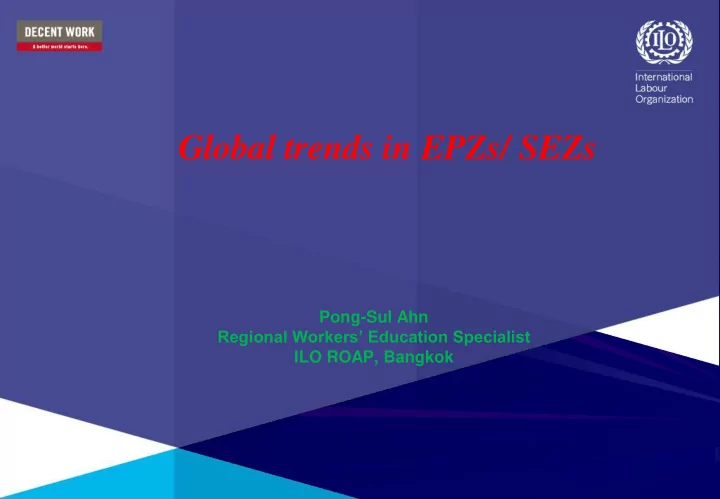

Global trends in EPZs/ SEZs Pong-Sul Ahn Regional Workers’ Education Specialist ILO ROAP, Bangkok
Key constitutive elements of an EPZ With special incentives Relatively small, geographically separated areas To attract export-oriented industries with free trade conditions and a liberal regulatory framework Limitation on trade union rights
ILO estimates on employment in EPZs Geographical area Estimated number of Number of zones workers Asia 55,741,147 900+ Central America and 5,252,216 155 Mexico Middle East 1,043,597 50 North Africa 643,152 65 Sub-Saharan Africa 860,474 90+ United States 340,000 713 South America 459,825 43 Transition economies 1,400,379 400 Caribbean region 546,513 250 Indian Ocean 182,712 1 Europe 364,818 50 Pacific 145,930 14 TOTAL (estimations) 65,980,763 3500+ ILO: Trade union policy guide on EPZs (Geneva, 2015), p.10.
ILO estimates of employment trends in EPZs (2008) 1975 1986 1995 1997 2002 2006 Number of 29 47 73 93 116 130 countries with EPZs Number of EPZs 79 176 500 845 3000 3500 Employment n/a n/a n/a 22.5 43 66 (millions) -China n/a n/a n/a 18 30 40 -Other countries 0.8 1.9 N.A 4.5 13 26 ILO: Trade union policy guide on EPZs (Geneva, 2015), p.10.
Info on investing countries, sectors and export markets: Country Main investing Main sectors Main markets countries Singapore Japan, US, Food processing, US, ASEAN Mexico, Canada, textiles, chemicals, countries, Gulf Chile, Australia, electronics States, European New Zealand, etc components, etc Union, etc Malaysia Japan, UK, High-tech, food Japan, US, Germany, Italy, processing, Germany, Republic Finland, Taiwan, pharmaceuticals, etc of Korea, etc Switzerland, etc Thailand EU, US, Taiwan, Agricultural Republic of Korea, Singapore, etc products, minerals The Netherlands, and ceramics, Austria, Malaysia, plastic, electronics, Japan, India, US, etc etc ILO: Trade union policy guide on EPZs (Geneva, 2015), p.14.
Why do governments create EPZs? • Job creation and improved living standards • Transfer of skills and expertise to local human resources • Introduce new technology • Boost the export sectors • Foreign exchange earning • Creation of backward and forward economic linkages
Why do enterprises invest in EPZs? • Various incentives • Availability of affluent human resources • Strategic location close to markets • Quality of the infrastructure, including supply of raw materials • Benefits from trade agreements • Labour relations environment, including low labour costs
Sample of range of tax incentives for EPZs Donella Caspersz: Organizing Export Processing Zone Workers (Univ. of Western Australia)
Key challenges • Total bars on unionization • To replace unions with other types of workers’ organisations • Restrict union leaders to have access to EPZs • Limitations on collective bargaining • Limitations on strikes • Inadequate protections against anti-union discrimination • Gender-based discrimination
Tripartite Declaration of Principles concerning Multinational Enterprises and Social Policy (2017) - Industrial relations/ FOA No.48: enjoy adequate protection against acts of anti-union discrimination in respect of their employment No.49: enjoy adequate protection against any acts of interference by each other in their establishment, functioning and administration No.51: affiliate with int’l organisations of workers of their own choosing No.52: special incentives not include any limitation of workers’ FOA No.53: workers’ representatives not be hindered from meeting for consultation and exchange of views among themselves No.54: Governments should not restrict the entry of workers’ representatives who come from other countries
Collective bargaining No.55: the right to have representative organizations of their own choosing recognized for the purpose of CB No.56: promote the full development and utilization of machinery for voluntary negotiation No.57: provide workers’ representatives with such facilities to assist CB No.59: should not threaten the transfer of the whole or part of an operating unit from the country No.60: CB should include provisions for the settlement of disputes No.61: provide workers’ representatives with information required for meaningful negotiation No.62: governments should provide workers’ representatives, on request, with information
ILO instruments related to freedom of association and gender equality Freedom of Association and Protection of the Right to Organize Convention, 1948 (No. 87) Right to Organize and Collective Bargaining Convention, 1949 (No. 98) Equal Remuneration Convention, 1951 (No. 100) Recommendation concerning Equal Remuneration for Men and Women Workers for Work of Equal Value, 1951 (R. No. 90) Discrimination (Employment and Occupation) Convention, 1958 (No.111) Discrimination (Employment and Occupation) Recommendation, 1958, (R. No. 111) Workers with Family Responsibilities Convention, 1981 (No. 156) Workers with Family Responsibilities Recommendation, 1981 (R. No. 165) Maternity Protection Convention, 2000 (No. 183)
Union strategies • Social dialogue, involving - the state - the employers - society • FOA, Collective Bargaining and Organising
• Advocacy - legal advocacy - media advocacy • Campaigns - petitions - distributing fliers and information sheets - public meetings - demonstrations - street theatre - online media mobilisation
Thank You
Recommend
More recommend